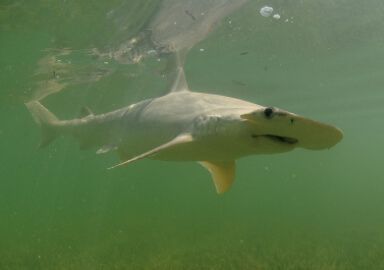Bull Shark
Bull sharks are fairly aggressive, large sharks of many warmer coastal and inland waters that, in some ways, epitomise what people fear about sharks.
View 12 listings
12
listings
–
price starting from
3
countries
–
to the nearest trip
Where and When?
Bull sharks are found in most warm water inshore areas around the world. They often enter turbid rivers and have been found over 4 000 kilometers (2 485 Miles) up the Amazon River and well over 1 000 kilometers (621 miles) up the Mississippi River. Following flooding events they can become trapped and live for many years in coastal or even suitable inland lakes. In the Atlantic Ocean they are found off the Americas from Massachusetts in the north to Argentina in the south. In the eastern Atlantic Ocean they are distributed from Morocco in the north to Angola in the south, but, wherever they are found, they are rarely far from the shore or at least shallow water. Bull sharks are comfortable in muddy waters and often find food using the “bump and bite” method. They seem to undergo a seasonal movement into cooler areas in summer and return to warmer waters when temperatures fall. Bull sharks feed both in the day and night throughout the year but seem to be particularly active around dusk and dawn.
About Bull Shark
The bull or Zambezi shark (Carcharhinas leucas) is a requiem shark meaning that it is a live bearing, warm water shark of the Carcharhinidae family. It is responsible for a fair proportion of inshore shark attacks on people and is well known for being found hundreds or even thousands of kilometers upstream in rivers. It is a robust, well rounded shark that is grey on its dorsal side and much paler below. The females are larger than the males and they have relatively small eyes, feeding often by smell and the second dorsal fin is smaller than the anterior one. They are opportunistic feeders eating a wide variety of organisms, but gravitate to eating mostly fish as they mature. The bull shark is well known, however, for occasionally eating birds, turtles and dolphins.
Bull sharks have been recorded growing to over 3.5 meters ( 138 ins.) and 400 kilograms (881 lbs.) in some areas but more common sizes are around 2.4 meters (8 ft.) and 130 kilograms (287 lbs.) They are usually solitary but may team up with similar sized bull sharks. They mate in late summer; gestation takes 12 months and results in 1- 13 “pups” that are born at around 70 centimeters (28 ins.) long. Young are usually born in “nurseries”, that are sheltered areas, often in estuaries or lagoons.
How to Catch?
Bull sharks are a popular shark species for game anglers both for sport and, mostly with smaller specimens, the table. They can be caught in many suitable lakes and rivers but are usually most abundant in shallow, sheltered, murky inshore waters. You can catch the bull shark from the shore, especially in rivers and some estuaries, while boat based operations, usually using small boats, are popular and appropriate in many inshore waters. Bull sharks occasionally take the bait, or hooked fish, of casual estuarine anglers and this often ends up inconclusively as the shark will usually cut the line. With true shark fishing, regardless of the size expected, strong, purpose-built heavy tackle is required.
Several methods of catching bull sharks exist, but the most popular one in most areas is the use of live bait. Other anglers prefer fairly large chunks of natural bait such as pieces of fish. In calm waters some people cast live bait out with a balloon attached and can easily see when a shark has taken the bait. Regardless, it is usually best to use “circle” hooks and let the fish take line freely for a few seconds before tightening the drag. Once the drag is tight all hell is likely to break loose. Bull shark fishing is not for the faint hearted and extreme care should be used when removing the hook.
Similar Species
 Blacktip Shark
19 offers
Blacktip Shark
19 offers
 Blue Shark
8 offers
Blue Shark
8 offers
 Bonnethead Shark
6 offers
Bonnethead Shark
6 offers
 Great White Shark
1 offer
Great White Shark
1 offer
 Greenland Shark
1 offer
Greenland Shark
1 offer
 Hammerhead Shark
8 offers
Hammerhead Shark
8 offers
 Lemon Shark
3 offers
Lemon Shark
3 offers
 Leopard Shark
1 offer
Leopard Shark
1 offer
 Mako Shark
26 offers
Mako Shark
26 offers
 Porbeagle Shark
2 offers
Porbeagle Shark
2 offers
 Shark
128 offers
Shark
128 offers
 Thresher Shark
4 offers
Thresher Shark
4 offers
 Tiger Shark
10 offers
Tiger Shark
10 offers
 Tope Shark
2 offers
Tope Shark
2 offers





